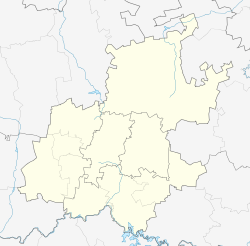Kleinfontein
| Kleinfontein | |
|---|---|
| Motto: Ons God, Ons Volk, Ons Land | |
|
|
|
| Coordinates: 25°49′55″S 28°30′04″E / 25.832°S 28.501°ECoordinates: 25°49′55″S 28°30′04″E / 25.832°S 28.501°E | |
| Country | South Africa |
| Province | Gauteng |
| Municipality | City of Tshwane |
| Established | 1992 |
| Area | |
| • Total | 8.6 km2 (3.3 sq mi) |
| Population | |
| • Total | 650 |
| • Density | 76/km2 (200/sq mi) |
| Website | http://www.kleinfontein.net/ |
Kleinfontein (Afrikaans for Small Fountain) is a new settlement near Pretoria, South Africa that was founded by Afrikaners in 1992 as a cultural village. It has only recently been developed and has a limited economy. It was founded by descendants of the original Voortrekkers or Boers, who seek self-determination in an autonomous Volkstaat. The criteria to live in Kleinfontein are based on cultural, linguistic, traditional and religious beliefs and its people associate themselves with the Voortrekker history, the Blood River Covenant and other "historical facts relating to our struggle for independence for the Afrikaner people".
As of 2012[update], it was one of South Africa's few remaining whites-only settlements. The settlement has been recognised as a cultural community by the Gauteng Legislature.
The land which would become Kleinfontein came to the attention of Afrikaner activists in 1988 during a celebration of the 150th anniversary of the Great Trek on a farm east of Pretoria. The farm drew their attention as a location of the Bittereinders and site of the Battle of Diamond Hill, as well as holding a historic Boer War cemetery and memorial. When the farm was put up for sale in 1992, a group of 50 Afrikaners purchased the property, and began to recruit shareholders to develop it.
In 1994, sufficient shareholders were recruited to service the loan and Kleinfontein could begin to provide services. The first two permanent houses were completed in 1996, and the first two families became permanent residents of Kleinfontein. In the ensuing years, Radio Pretoria erected its broadcasting tower on Kleinfontein, sports fields were built, a homegrown school was established and a savings and credit cooperative had emerged. A community hall, care center and retirement homes followed as well as a shopping center with an ATM. The entrance to the town displays a bust of Hendrik Verwoerd, the "father of apartheid"; the community obtained the bust from a neighbouring town which no longer wanted it.
...
Wikipedia



